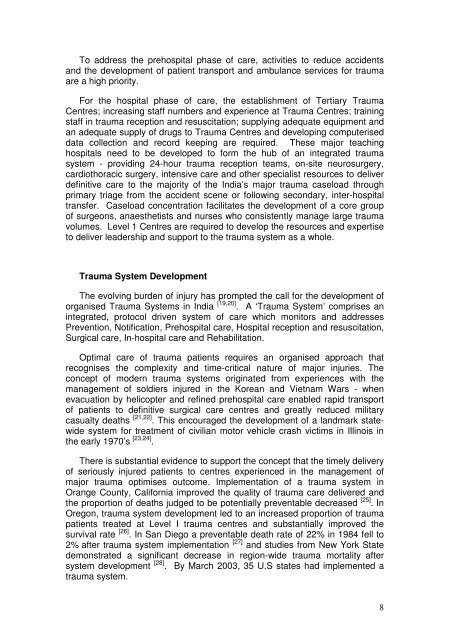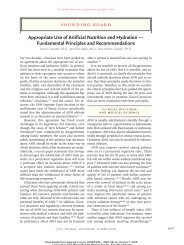India and the Management of Road Crashes ... - Alfred Hospital
India and the Management of Road Crashes ... - Alfred Hospital
India and the Management of Road Crashes ... - Alfred Hospital
- No tags were found...
Create successful ePaper yourself
Turn your PDF publications into a flip-book with our unique Google optimized e-Paper software.
To address <strong>the</strong> prehospital phase <strong>of</strong> care, activities to reduce accidents<strong>and</strong> <strong>the</strong> development <strong>of</strong> patient transport <strong>and</strong> ambulance services for traumaare a high priority.For <strong>the</strong> hospital phase <strong>of</strong> care, <strong>the</strong> establishment <strong>of</strong> Tertiary TraumaCentres; increasing staff numbers <strong>and</strong> experience at Trauma Centres; trainingstaff in trauma reception <strong>and</strong> resuscitation; supplying adequate equipment <strong>and</strong>an adequate supply <strong>of</strong> drugs to Trauma Centres <strong>and</strong> developing computeriseddata collection <strong>and</strong> record keeping are required. These major teachinghospitals need to be developed to form <strong>the</strong> hub <strong>of</strong> an integrated traumasystem - providing 24-hour trauma reception teams, on-site neurosurgery,cardiothoracic surgery, intensive care <strong>and</strong> o<strong>the</strong>r specialist resources to deliverdefinitive care to <strong>the</strong> majority <strong>of</strong> <strong>the</strong> <strong>India</strong>’s major trauma caseload throughprimary triage from <strong>the</strong> accident scene or following secondary, inter-hospitaltransfer. Caseload concentration facilitates <strong>the</strong> development <strong>of</strong> a core group<strong>of</strong> surgeons, anaes<strong>the</strong>tists <strong>and</strong> nurses who consistently manage large traumavolumes. Level 1 Centres are required to develop <strong>the</strong> resources <strong>and</strong> expertiseto deliver leadership <strong>and</strong> support to <strong>the</strong> trauma system as a whole.Trauma System DevelopmentThe evolving burden <strong>of</strong> injury has prompted <strong>the</strong> call for <strong>the</strong> development <strong>of</strong>organised Trauma Systems in <strong>India</strong> [19,20] . A ‘Trauma System’ comprises anintegrated, protocol driven system <strong>of</strong> care which monitors <strong>and</strong> addressesPrevention, Notification, Prehospital care, <strong>Hospital</strong> reception <strong>and</strong> resuscitation,Surgical care, In-hospital care <strong>and</strong> Rehabilitation.Optimal care <strong>of</strong> trauma patients requires an organised approach thatrecognises <strong>the</strong> complexity <strong>and</strong> time-critical nature <strong>of</strong> major injuries. Theconcept <strong>of</strong> modern trauma systems originated from experiences with <strong>the</strong>management <strong>of</strong> soldiers injured in <strong>the</strong> Korean <strong>and</strong> Vietnam Wars - whenevacuation by helicopter <strong>and</strong> refined prehospital care enabled rapid transport<strong>of</strong> patients to definitive surgical care centres <strong>and</strong> greatly reduced militarycasualty deaths [21,22] . This encouraged <strong>the</strong> development <strong>of</strong> a l<strong>and</strong>mark statewidesystem for treatment <strong>of</strong> civilian motor vehicle crash victims in Illinois in<strong>the</strong> early 1970’s [23,24] .There is substantial evidence to support <strong>the</strong> concept that <strong>the</strong> timely delivery<strong>of</strong> seriously injured patients to centres experienced in <strong>the</strong> management <strong>of</strong>major trauma optimises outcome. Implementation <strong>of</strong> a trauma system inOrange County, California improved <strong>the</strong> quality <strong>of</strong> trauma care delivered <strong>and</strong><strong>the</strong> proportion <strong>of</strong> deaths judged to be potentially preventable decreased [25] . InOregon, trauma system development led to an increased proportion <strong>of</strong> traumapatients treated at Level I trauma centres <strong>and</strong> substantially improved <strong>the</strong>survival rate [26] . In San Diego a preventable death rate <strong>of</strong> 22% in 1984 fell to2% after trauma system implementation [27] <strong>and</strong> studies from New York Statedemonstrated a significant decrease in region-wide trauma mortality aftersystem development [28] . By March 2003, 35 U.S states had implemented atrauma system.8
















